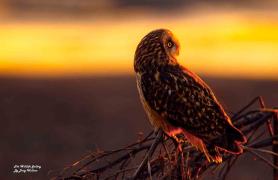Got a question for Ask MDC? Send it to AskMDC@mdc.mo.gov or call 573-522-4115, ext. 3848.
Q: What are some of the common markings of a native bobcat?
Bobcats are yellowish- to reddish-brown cats with both black striped and spotted patterns on their bodies. They have long hind legs, short, broad faces, and short “bobbed” tails, which can be from 3½ to 8 inches long. The backs of their ears are black with a central light-colored spot and occasionally black tufts. Both sexes look alike. The pupils of their eyes are oval (vertically narrowed) in bright light but nearly round in dim light. Bobcats and their dens have a very strong odor.
Originally, bobcats ranged from southern Canada, throughout the United States, and most of Mexico. However, they were extirpated from much of the central United States by 1900 due to habitat loss. Through conservation efforts, bobcat numbers have rebounded in many areas of their distribution. In Missouri, bobcats can be found statewide, and their populations are stable.
When rabbits, moles, voles, and squirrels are in abundance, bobcats can inhabit many different areas, including areas near human populations without incident. Active both during the night and day, these felines mark their territories with scat, but don’t socialize much. Within their ranges, they can travel between 3 and 7 miles nightly.
Mating begins in December, and litters of two to three kittens are usually born in May and June. Weaning occurs after two months, and young stay with the female until fall or later. For more information, visit short.mdc.mo.gov/4ir.
Q: I think I’ve seen woodcocks in downtown St. Louis. Is that possible in December? One appeared injured and the other seemed disoriented but successfully flew away.
Yes, it is possible. American woodcocks migrate later compared to songbirds. Missouri’s peak occurs in late October and November, but it’s common to see them in December, too. Like waterfowl moving south through the continental United States, woodcocks stop where food is available. American woodcocks forage for earthworms in young woodlands near water, in moist pastures, and forested floodplains. The tip of their long bill is flexible, and the bird uses it to probe soft ground for its prey.
During migration, MDC receives reports of exhausted American woodcocks and Wilson’s snipes found in urban yards and parking lots. Seeing a Wilson’s snipe is more common. To see a comparison of the two species, visit short.mdc.mo.gov/ZpK.
Often, these birds just need a break and will continue their journey. Also, glass window strikes are common for birds, leaving them injured and disoriented. You can help these exhausted migratory birds by keeping cats indoors. The St. Louis Audubon Society is a good resource to learn how to keep birds safer in the St. Louis region. To learn more, visit short.mdc.mo.gov/Zpv.
Also In This Issue

Readers find the beauty in nature through their lenses
And More...
This Issue's Staff
Editor - Angie Daly Morfeld
Associate Editor - Larry Archer
Photography Editor - Cliff White
Staff Writer - Kristie Hilgedick
Staff Writer - Joe Jerek
Staff Writer – Dianne Van Dien
Designer - Shawn Carey
Designer - Marci Porter
Photographer - Noppadol Paothong
Photographer - David Stonner
Circulation – Marcia Hale






















